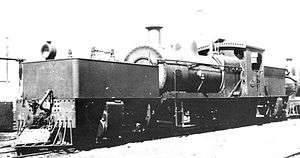WAGR S class
The WAGR S class was a class of 4-8-2 steam locomotives built by the Midland Railway Workshops between 1943 and 1947 and operated by the Western Australian Government Railways (WAGR).
| WAGR S class | |||||||||||||||||||||||||
|---|---|---|---|---|---|---|---|---|---|---|---|---|---|---|---|---|---|---|---|---|---|---|---|---|---|
 Preserved S549 Greenmount at Harvey following restoration to working condition | |||||||||||||||||||||||||
| |||||||||||||||||||||||||
| |||||||||||||||||||||||||
| |||||||||||||||||||||||||
| |||||||||||||||||||||||||
Details of Design
The S class locomotives were built with a 4-8-2 wheel arrangement, a configuration commonly used in Australia for heavy goods locomotives, smaller driving wheels giving increased tractive effort at the cost of reduced speed.
History
Background
In the 1920s and 1930s the West Australian rail system was thoroughly run down. The vast majority of locomotives were well past their useful service life and many were badly in need of repairs. The P and Pr classes had helped alleviate pressure on aging passenger locomotives when introduced in 1924 and 1938 respectively, but more powerful machines were needed with an order for 10 authorised.
Operational history
The first three were built in 1943, with the remaining seven deferred while Midland Railway Workshops completed its order for 10 Australian Standard Garratts for the Commonwealth Land Transport Board. A further two were completed in 1945, with the remaining five deferred again until 1947 while the Dm and Dd classes were built.[1]
The class was initially intended for service on both passenger and goods services on the Eastern Goldfields Railway between Perth and Kalgoorlie, though following World War II it worked primarily on the South Western Railway. After suffering from a range of early problems (which led to controversy involving the designer Frederick Mills), the class became highly popular and was very successful.[2][3][4]
The locomotives were given running-board nameplates and were named after Western Australian mountains, following the tradition established five years earlier with the Pr class, which were named after Western Australian rivers.[1] The locomotives were fitted with steam brakes, the tenders with vacuum brakes. All were fitted with semi-streamlining cowling over the entire length of their tops although this was later removed. The tenders were rebuilt reducing their coal capacity from nine to seven tonnes while increasing their water capacity from 15,900 to 22,700 litres.[1][4]
Most were condemned in 1971, with S549 operating the last WAGR steam hauled freight service on 24 December 1971.[5]
Preservation
Three have been preserved:[4][5][6]
- S542 Bakewell is plinthed at East Perth Terminal, once the site of the East Perth Locomotive Depot
- S547 Lindsay is preserved on the Bellarine Railway in Victoria[7]
- S549 Greenmount is preserved by Rail Heritage WA, restored to working order in 1995
Class list
The numbers, names and periods in service of each member of the S class were as follows:[8]
|
Namesakes
The S class designation was previously used for the S class locomotives that were withdrawn in 1916. It was reused from 1998 when the Westrail S class diesel locomotives entered service.
References
Notes
- Gunzburg 1984, p. 117.
- Finlayson, Don (1986). Steam Around Perth. Perth: Australian Railway Historical Society WA Division. p. 50. ISBN 0959969047.
- Turner, Jim (1997). Australian Steam Locomotives 1896-1958. Kenthurst: Kangaroo Press. p. 126. ISBN 086417778X.
- Oberg, Leon (2010). Locomotives of Australia 1850s-2010. Dural: Rosenberg Publishing. pp. 223–224. ISBN 9781921719011.
- Whiteford, David; De Bruin, Charles; Watson, Lindsay; Watson, Neville (1983). Western Australian Preserved Locomotives. Elizabeth: Railmac Publications. p. 16. ISBN 0 949817 19 8.
- McNicol, Steve (1994). WAGR Steam Locomotives in Preservation. Elizabeth: Railmac Publications. ISBN 9780949817976.
- Locomotives Archived 2017-05-25 at the Wayback Machine Bellarine Railway
- Gunzburg 1984, p. 119.
- East Perth Bakewell Locomotive Remediation Public Transport Authority
- S547 Australian Steam
Bibliography
- Gunzburg, Adrian (1968). WAGR Locomotives 1940–1968. Perth: Australian Railway Historical Society (Western Australian Division). pp. 7–9, 47. OCLC 219836193.
- Gunzburg, Adrian (1984). A History of WAGR Steam Locomotives. Perth: Australian Railway Historical Society (Western Australian Division). ISBN 0959969039.
External links
![]()

